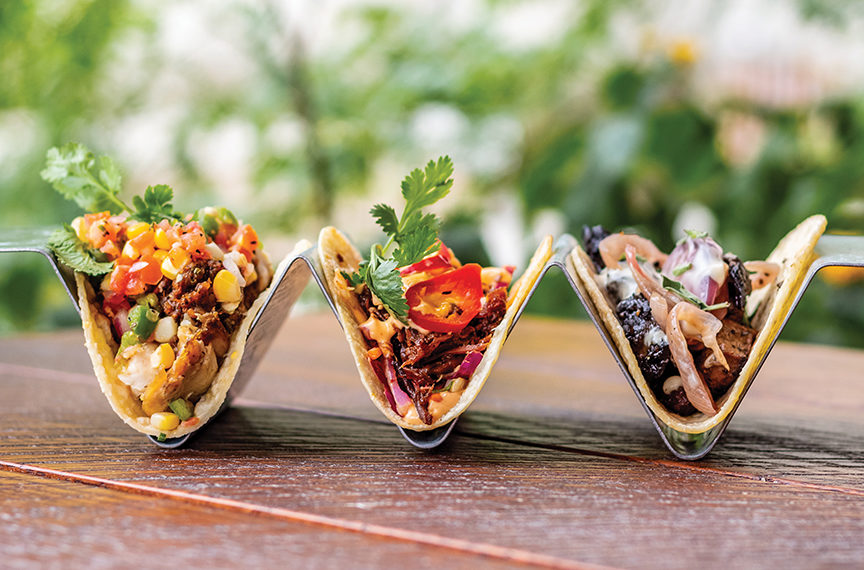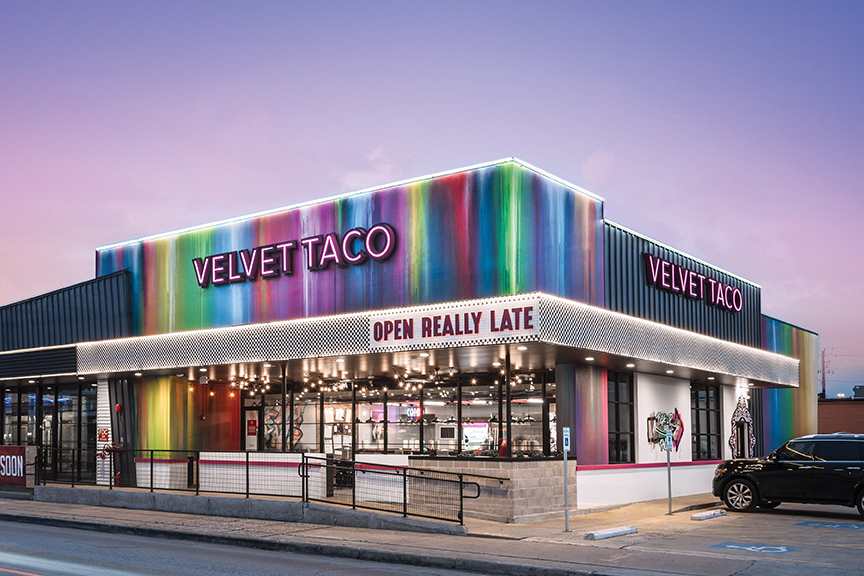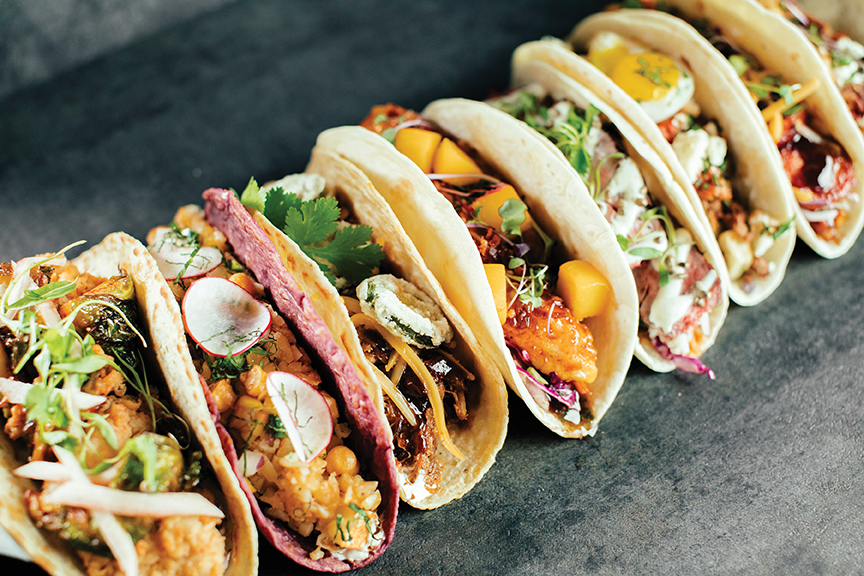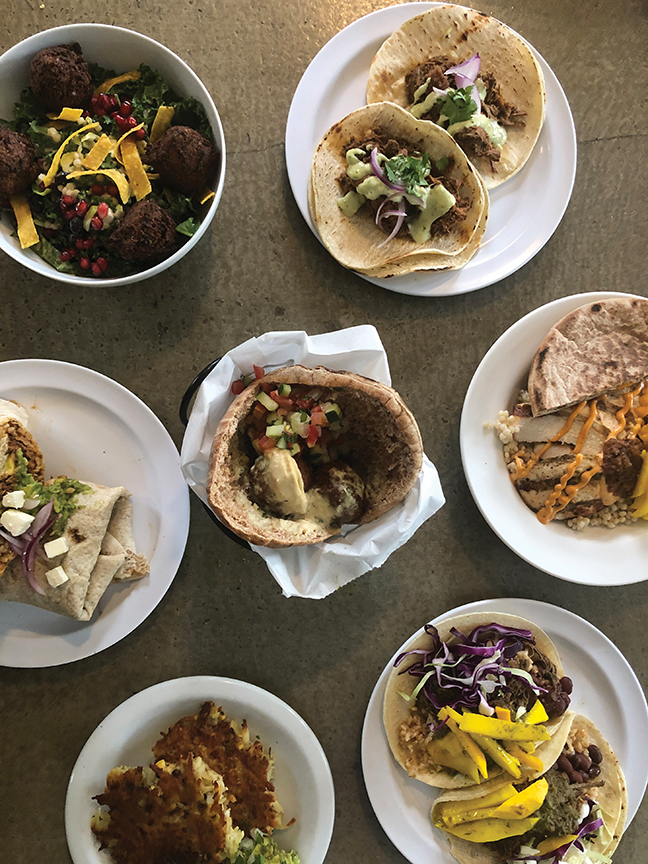By Roger Grody
Tacos are the ultimate street food, and college kids, frazzled moms and anybody on a budget knows they are also typically a great value. But as the tradition of “Taco Tuesday” has spread from the American Southwest through the entire nation, innovative chefs have begun incorporating luxurious or unexpected ingredients into tacos, elevating the humble dish to new heights.
Nobu Malibu, typically overrun by celebrities on weekends, features a variety of upscale tacos fashioned from wonton shells. The fashionable outpost of sushi master/entrepreneur Nobu Matsuhisa offers miniature tacos stuffed with luxury ingredients such as uni, Wagyu beef and lobster, all providing a suitable homage to the Mexican heritage of Southern California.
In New York, chef Alex Stupak — he co-authored the James Beard Award-nominated book Tacos: Recipes and Provocations — explores the versatility of the taco at his growing collection of Empellón Taquerias. In the book’s introduction, the chef characterizes the recipes for taco fillings he presents on the following pages, presenting unconventional concepts like chicken wing tacos or pastrami tacos that intrigue readers. “Some are classic, like sticky pork carnitas, musky tripe or cochinita pibil. Others use tradition as a springboard for innovation or as an opportunity to explore my own roots in a Mexican context,” he explains. Stupak’s oyster tacos are a nod to his New England heritage and his foam-topped tacos are the product of years working in trendy American kitchens.
Since it was founded in Dallas in 2011, Velvet Taco has spread like wildfire throughout Texas and to Georgia, Illinois and beyond, promoting itself as a “temple to the liberated taco.” Without the constraints of strict authenticity or national borders, its chefs have been free to create a culturally diverse taco menu that includes Southern shrimp-and-grits, Indian-inspired chicken tikka, Nashville hot tofu, Korean fried rice, chicken-and-waffle, Buffalo chicken, and an interpretation of a Cuban sandwich folded into a flour tortilla.
Chef V Willis, who directs the culinary operations at Velvet Taco, states, “The brand is founded on the idea that tacos don’t have to be Mexican, or Tex-Mex.” As a result, some purists may find Velvet Taco’s eclectic, chef-driven approach to tacos unnerving, but it resonates with adventurous diners. “When creating a menu, we’re always exploring new ingredients, flavors, seasonal trends, and cultures,” says Willis.
Noting the perfect taco is a balance of flavors, textures and colors, Willis insists there are no rules for the taco as a vessel for the delivery of diverse, even unexpected flavors. “You can put anything into a taco, and even the ingredients that go into making the tortilla can be unique and nontraditional,” she says. “Connecting people with global flavors through an approachable staple, like a taco, is important to us,” explains the chef.
At New York’s Bar Masa, from sushi master Masa Takayama, diners enjoy rich, cross-cultural tacos filled with crispy Peking duck, whose sweet hoisin sauce complements an additional indulgent filling of seared foie gras. In Miami, The Bazaar by José Andrés — a fusion of scene and cuisine in perennially trendy South Beach — offers high-end tacos, including a Japanese-influenced version with grilled eel, shiso, wasabi, and pork chicharrónes stuffed into a cucumber “tortilla.” Another taco, informed by the famous chef’s native Spain, features Ossetra caviar wrapped in prized Ibérico ham.
Chef Roy Choi was a pioneer in the food truck movement, creating addictive street food that combined the seemingly disparate ingredients he grew up with. Born in Seoul but raised in L.A., the young chef realized his two favorite cuisines, Korean and Mexican, could be harmonized in dishes like kimchi quesadillas or Korean short rib tacos. The concept has been an unbridled success, as a fleet of Choi’s instantly recognizable Kogi trucks, a local favorite since 2008, continue to rumble through the streets of Southern California. The chef, a renegade at heart despite his Culinary Institute of America credentials, was instrumental in making the taco a vehicle for anything a clever chef might imagine.
In Pleasantville, New York, veteran chef Jonathan Langsam and his Mexican-born wife Rosie Hernandez-Langsam combine Israeli and Mexican traditions at a restaurant called Falafel Taco. The menu offers appealing mashups such as potato latkes or matzo ball soup with Mexican twists, and tacos stuffed with Jewish specialties like slow cooked brisket (a riff on Langsam’s grandmother’s recipe) or Israeli falafel. The genesis of the concept was Langsam stuffing falafel into pita bread (options at the restaurant include Israeli pita, laffa or corn tortilla) at home to please his vegan-leaning children. “We thought about opening a taquería or a falafel place, and ended up doing both,” explains the chef, who adds, “Our menu is really about street food,” a grab-and-go concept well suited to the restaurant’s train station location.
“What Mexican and Israeli cuisines have in common is that everything has to be fresh, and the flavors have to intrigue and excite you,” says Langsam, who draws parallels between a finely chopped Israeli salad and Mexican pico de gallo. The curious cultural hybrid has been a hit, and the culinary couple is opening a second Falafel Taco in nearby Greenwich, Connecticut.
The Grand Velas Los Cabos resort in Mexico offers a $25,000 taco, a gold-infused corn tortilla stuffed with langoustine, Kobe beef, Beluga caviar and black truffled Brie cheese. For an extra $150,000, the gilded taco can be paired with Ley .925 “Pasión Azteca” Ultra-Premium Añejo Tequila in a custom- designed bottle accented in gold and platinum.
“Our ultimate goal at Grand Velas Los Cabos is to break the mold of expected, traditional cuisine, going outside the box and creating new, exciting experiences for our well-traveled guests,” explains Andreas Schmidt, the resort’s managing director.







Leave a Reply